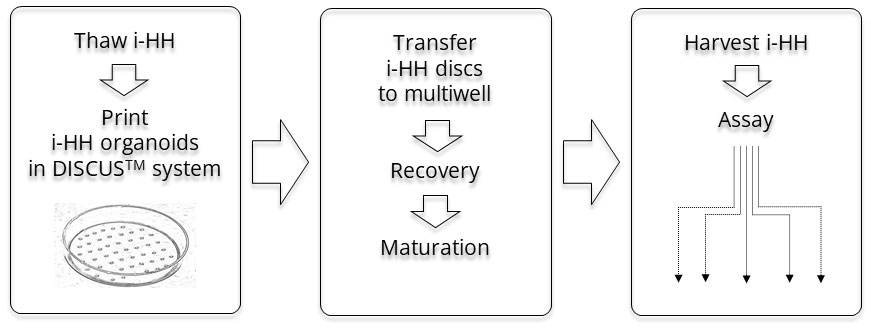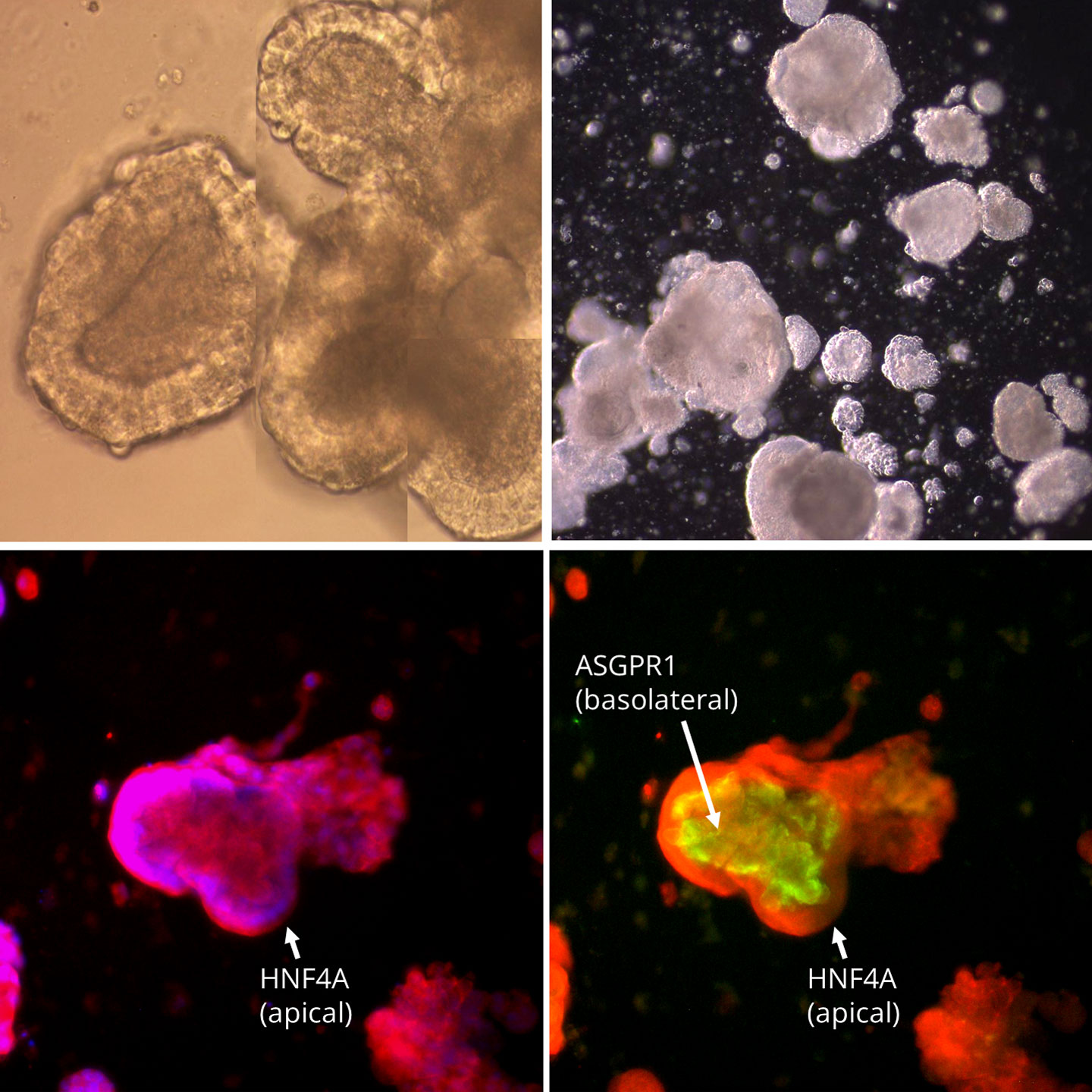Description
Hepatocytes are essential for critical processes like metabolism, detoxification, protein synthesis, and innate immunity. A robust cellular model is required to study these hepatocyte processes, as well as liver development, toxicity, disease and more. However, current models have significant limitations.
Primary hepatocytes are inconvenient to isolate, do not tolerate cryopreservation, do not proliferate in culture, and senesce rapidly. Alternatively, cell lines like HepG2 can divide in vitro, but are cancer cells and do not display normal hepatocyte function. After about 1 week in standard cell culture format, cell lines like HepG2 becomes overgrown with necrotic colonies, and are no longer suitable for experiments. Furthermore, the majority of current hepatocyte models are 2-dimensional, a format that is unlikely to mimic the 3-dimensional niche that hepatocytes occupy in the body.
To address these liver research needs, Cell Applications now offers a breakthrough, first-of-its kind hepatocyte system. Using our DISCUS™ Technology to generate true three-dimensional tissue constructs, Cell Applications iPSC-derived Human Hepatocytes (i-HH) recapitulate hepatic development, generating 3D organoids with polarized structures capable of multiweek culture. The i-HH are well-characterized, and are demonstrated to express xenobiotic metabolizing enzymes, and demonstrate other key liver specific functions, including albumin secretion and ammonia detoxification.
i-HH demonstrates extended albumin secretion, urea production, and CYP3A4 activity

i-HH demonstrates extended album secretion, urea production, and CYP3A4 activity, outperforming HepG2 in the DISCUS™ 3D system. Above graphs: Vital liver functions include production of albumin for molecule transport, urea from ammonia detoxification, and drug metabolizing enzymes like CYP3A4. As shown here, i-HH in the DISCUS™ 3D system possess all three activities. For reference, primary hepatocyte ranges are 4-20 ug/mL Albumin,2 48-255 nmol Urea,3 and 0.3-3.60E6 RFU CYP3A4 activity.4 Furthermore, i-HH outperforms HepG2 in both 2D monolayer (HepG2 -2D) and DISCUS™ 3D system (HepG2-3D) cultures. Adherent HepG2-2D cell cultures could only be cultured for one week before becoming overgrown.
i-HH express liver markers HNF4A and ASPGR1

i-HH expresses liver markers HNF4A and ASPGR1, which are characteristic of functioning hepatocytes.1 Above Left: A 3D i-HH organoid stained with HNF4A (red) and ASPGR1 (green). The in-focus plane demonstrates a clear nuclear HNF4A signal on the apical exterior, and ASPGR1 signal on the basolateral interior. Above Right: HNF4A is a hepatocyte-specific transcription factor and ASPGR1 is a functional hepatocyte marker. Cell Applications’ 3D i-HH, derived from two separate HiPSC lines (1709 and 1439), have 87% of the cells express double positive HNF4A/ASPGR1 markers for up to four weeks.
The i-HH Total Kit DISCUSTM system

The HiPSC-derived Human Hepatocyte (i-HH) Total Kit from Cell Applications is a 3D cell culture model that utilizes the DISCUSTM gel system. The cell-specific DISCUSTM system of 3D discs address the challenges of anoxia and diffusion limits in 3D tissue engineering. Measuring 3mm across, and 600 microns deep at its thickest point, these versatile units need only common, inexpensive laboratory equipment to generate your 3D engineered tissue of choice. The i-HH Total Kit is an all-in-one package that includes cryopreserved i-HH, DISCUSTM gel kit, DISCUSTM dissociation solution, and optimized Recovery and Maturation Media that allow for the culture of the cells in a 3-D culture.
1. Peters, et al. Development (2016) 1475-1481
2. Lubberstedt, et al. J Pharm Tox Methods (2011) 59-63
3. Donato, et al. Cell Transplantation (2008) 1211-1219
4. Gramignoli, et al. Cell Tranplantation (2014) 1545-1556
Details
| Source | Derived from Human iPSC of a single donor |
| QC | No bacteria, yeast, fungi, mycoplasma, virus |
| Bioassay | Albumin secretion, Urea production, CY3A4 activity |
| Cryovial | Approxiately 500,000 equivalents of i-HH (2nd passage) in freezing medium |
| Kit | Cryovial frozen i-HH cells (i780-05), i-HH Recovery Medium Kit (i71103K-30), i-HH Maturation Medium Kit(i71105K-100), i-HH Metabolic Medium Kit (i71107K-30), DISCUS-111 i-HH Kit (DISC1053K), DISCUS Dissolution Reagent (DISC1050), Non-Stick Solution (1025-05) |
| Cultured | Contact us for availability |
| Doublings | Cells can be cultured for up to 3-4 weeks in DISCUSTM system. Cells do not divide, and cannot be passaged. |
| Applications | Laboratory research use only (RUO). Not for human, clinical, diagnostic or veterinary use. |
Products
| Product | Size | CAT.# | Price | Quantity |
|---|---|---|---|---|
| Cryopreserved Human Hepatocytes Total Kit, iPSC-derived: Cells, Medium & Reagents (See Details tab for specifics) | Size: 1 Kit | CAT.#: i780K-05 | Price: $1,437.00 | |
| Cryopreserved Human Hepatocytes, iPSC-derived: Frozen Human iPSC-Derived Human Hepatocytes (5x10^5) | Size: 1 Cryovial | CAT.#: i780-05 | Price: $998.00 |
Related Products
| Product | Size | CAT.# | Price | Quantity |
|---|---|---|---|---|
| i-HH Recovery Medium Kit: Basal medium & supplements sold together packaged separately. Combine all for complete medium. | Size: Yields 30 ml | CAT.#: i71103K-30 | Price: $88.00 | |
| i-HH Maturation Medium Kit: Basal medium & supplements sold together packaged separately. Combine all for complete medium. | Size: Yields 100 ml | CAT.#: i71105K-100 | Price: $128.00 | |
| i-HH Metabolic Medium Kit: Basal medium & supplements sold together packaged separately. Combine all for complete medium. | Size: Yields 30 ml | CAT.#: i71107K-30 | Price: $88.00 | |
| i-HH DISCUS 3D Gel Kit: Cell Applications 3D system for iPSC-derived human hepatocytes. | Size: 1 Kit | CAT.#: DISC1053K | Price: $75.00 | |
| DISCUS Dissolution Reagent: Reagent for DISCUS dissolution. | Size: 10 ml | CAT.#: DISC1050 | Price: $35.00 | |
| DISCUS Non-Stick Solution: Reagent for cell culture. | Size: 5 ml | CAT.#: 1025-05 | Price: $35.00 |

